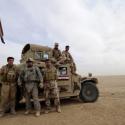Operation Marne Torch I
A division-level operation to clear the areas along the Tigris River southeast of Baghdad during Operation Phantom Thunder.
A division-level operation to clear the areas along the Tigris River southeast of Baghdad during Operation Phantom Thunder.
The southeastern belt wraps around the capital in an arc running from Nahrawan east of Baghdad, south through Jisr Diyala down to Salman Pak, and east through Arab Jabour and Hawr Rajab to the city of Mahmudiyah. Most of the area is rural farmland, crisscrossed by irrigation canals that limit mobility and facilitate the creation of insurgent refuges.
The Baghdad belts are residential, agricultural, and industrial areas that encircle the city, and networks of roadways, rivers, and other lines of communication that lie within a twenty or thirty mile radius of Baghdad and connect the capital to the rest of Iraq. Beginning in the north, the belts include the cities of Taji, clockwise to Tarmiyah, Baqubah, Buhriz, Besmayah and Nahrwan, Salman Pak, Mahmudiyah, Sadr al-Yusufiyah, Fallujah, and Karmah.
The mid-Euphrates region of Iraq lies south of Baghdad. Its main cities include Karbala, Hillah, Kut (الكوت), Diwaniyah (الديوانية), and Najaf (النجف). The population is predominantly Shi'a in the south and generally a mixture of Sunni and Shi'a to the north of Hillah and northwest of Kut. Iraqi Security Forces (ISF) play an important role in this region, particularly the 8th Iraqi Army Division led by the capable General Othman Ali Ferhood.
Although one of the smallest factions in the Sunni insurgency, Al-Qaeda in Iraq may be one of the most deadly. US operations have put tremendous pressure on the group.
MND-C operation aiming to promote security in the southern and eastern belts of Baghdad.

This is the first in a series of reports profiling the units of the 6th Iraqi Army Division. The units discussed here are located west and south of Baghdad.

Phantom Strike, a series of targeted joint operations against al Qaeda, Sunni, and Shi'a insurgent elements
in Baghdad and the surrounding areas, was launched on August 13, 2007.

What began in Anbar as a local movement of tribes is developing into a national phenomenon.